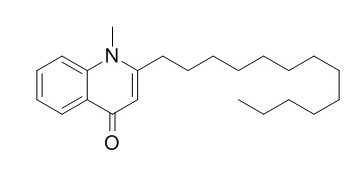Dihydroevocarpine
Dihydroevocarpine shows potent anti-Helicobacter pylori activity with the minimum inhibitory concentration (MIC) value of 10-20 microg/ml. Dihydroevocarpine is a moderate modulator of p-glycoprotein (p-gp) activity; it shows more potent inhibitory effects against MAO-B compared to MAO-A.
Inquire / Order:
manager@chemfaces.com
Technical Inquiries:
service@chemfaces.com
Tel:
+86-27-84237783
Fax:
+86-27-84254680
Address:
1 Building, No. 83, CheCheng Rd., Wuhan Economic and Technological Development Zone, Wuhan, Hubei 430056, PRC
Providing storage is as stated on the product vial and the vial is kept tightly sealed, the product can be stored for up to
24 months(2-8C).
Wherever possible, you should prepare and use solutions on the same day. However, if you need to make up stock solutions in advance, we recommend that you store the solution as aliquots in tightly sealed vials at -20C. Generally, these will be useable for up to two weeks. Before use, and prior to opening the vial we recommend that you allow your product to equilibrate to room temperature for at least 1 hour.
Need more advice on solubility, usage and handling? Please email to: service@chemfaces.com
The packaging of the product may have turned upside down during transportation, resulting in the natural compounds adhering to the neck or cap of the vial. take the vial out of its packaging and gently shake to let the compounds fall to the bottom of the vial. for liquid products, centrifuge at 200-500 RPM to gather the liquid at the bottom of the vial. try to avoid loss or contamination during handling.
Separations2023, 10(4),255.
J Appl Biol Chem.2024, 67:39,281-288.
Drug Chem Toxicol.2020, 1-12.
Food Chemistry: X2023, 101032.
Yakugaku Zasshi.2018, 138(4):571-579
Int. J. Mol. Sci. 2022, 23(3),1696.
Environ Toxicol.2024, tox.24246
J Traditional Thai Medical Res.2022, 8(1):pp1-14.
Chem. of Vegetable Raw Materials2020, 97-105
J Agric Food Chem.2021, 69(11):3496-3510.
Related and Featured Products
Planta Med. 2007 Dec;73(15):1554-7.
Cytotoxicity and p-glycoprotein modulating effects of quinolones and indoloquinazolines from the Chinese herb Evodia rutaecarpa.[Pubmed:
18058680 ]
The antimycobacterial quinolones 1-methyl-2-undecyl-4-quinolone, Dihydroevocarpine and evocarpine as well as the indoloquinazoline alkaloids rutaecarpine and evodiamine - all from the Chinese medicinal herb Evodia rutaecarpa - were tested in two in vitro assays, for cytotoxicity and interaction with p-glycoprotein (p-gp).
METHODS AND RESULTS:
Cytotoxicity was measured in a cell proliferation assay against CCRF-CEM leukemia cells and their p-gp over-expressing subline CEM/ADR5000. An assay monitoring the p-gp-dependent accumulation of the dye calcein in porcine brain capillary endothelial cells (PBCECs) was used to study interactions of the test substances with this efflux pump. Rutaecarpine and evodiamine showed quite high toxicity with IC (50) values from 2.64 to 4.53 microM and were weak modulators of p-gp activity.
CONCLUSIONS:
The degrees of resistance in CEM/ADR5000 towards the saturated quinolones 1-methyl-2-undecyl-4-quinolone and Dihydroevocarpine were between 3 and 4.
In the calcein assay, these two quinolones were shown to be moderate modulators of p-gp activity. Evocarpine, on the other side, is not transported by p-gp, and showed only slight toxicity at the highest test concentration of 30 microM.
Biol Pharm Bull. 1999 Oct;22(10):1141-3.
Anti-Helicobacter pylori activity of quinolone alkaloids from Evodiae fructus.[Pubmed:
10549874]
A biologically monitored fractionation of methanol extract of the fruit of Evodia rutaecarpa led to the isolation of six quinolone alkaloids, evocarpine (1), 1-methyl-2-[(4Z,7Z)-4,7-tridecadienyl]-4(1H)-quinolone (2), 1-methyl-2-[(6Z,9Z)-6,9-pentadecadienyl]-4(1H)-quinolo ne (3), 1-methyl-2-undecyl-4(1H)-quinolone (4), Dihydroevocarpine (5), 1-methyl-2-pentadecyl-4(1H)-quinolone (6).
METHODS AND RESULTS:
They showed potent anti-Helicobacter pylori activity with the minimum inhibitory concentration (MIC) value of 10-20 microg/ml. However, they had no effect on Helicobacter pylori urease activity at the concentration of 300 microg/ml.
Arch Pharm Res. 2007 Apr;30(4):397-401.
Quinolone alkaloids from evodiae fructus and their inhibitory effects on monoamine oxidase.[Pubmed:
17489352]
METHODS AND RESULTS:
1-Methyl-2-undecyl-4(1H)-quinolone (1) was previously isolated as a selective MAO-B inhibitor from the Evodiae Fructus. Further bioassay-guided purification led to the identification of five known quinolone alkaloids, 1-methyl-2-nonyl-4(1H)-quinolone (2), 1-methyl-2-[(Z)-6-undecenyl]-4(1H)-quinolone (3), evocarpine (4), 1-methyl-2-[(6Z,9Z)-6,9-pentadecadienyl]-4(1H)-quinolone (5), and Dihydroevocarpine (6). All the isolates showed more potent inhibitory effects against MAO-B compared to MAO-A.
CONCLUSIONS:
The most MAO-B selective compound 5 among the isolates inhibited MAO-B in a competitive manner, according to kinetic analyses by Lineweaver-Burk reciprocal plots.
Zhongguo Zhong Yao Za Zhi. 2014 Jul;39(14):2693-8.
Simultaneous determination of seven constituents in Euodiae Fructus and two related species by HPLC.[Pubmed:
25272498]
This study is to develop a HPLC method for quality evaluation of Euodiae Fructus and related species by simultaneous determination limonin, indole alkaloids (14-fomyldihydroxyrutaecarpine, evodiamine, rutaecarpine), and quinolone alkaloids [1-methyl-2-undecyl-4 (1H)-quinolone, evocarpine, Dihydroevocarpine] in the fruits of five Evodia species.
METHODS AND RESULTS:
Samples were analyzed on a YMC C18 column (4.6 mm x 250 mm, 5 microm) eluted with mobile phases of acetonitrile (A), tetrahydrofuran (B), and a buffer solution of 5 mmol x L(-1) ammonium acetate (pH 3.8) (C) in a linear gradient mode. The column temperature was 30 degrees C and the flow rate was 1.0 mL x min(-1). The PDA detector wavelengths were set at 220 and 250 nm. The seven compounds were well separated and showed good linearity (r = 0.999 9) within the concentration ranges tested. The mean recoveries were between 96.7%-102.4% (RSD 1.4%-3.1%). Through the validation, the method was proved to be accurate and repeatable. All the seven constituents were detected in the fruits of five species, but the contents of them varied widely in different samples.
CONCLUSIONS:
The total contents of seven constituents in 16 batches of Euodiae Fructus were 9.46-69.9 mg x g(-1), and the mean content was 28.2 mg x g(-1). The total content of seven constituents in E. compacta and E. fargesii was 25.8, 7.69 mg x g(-1), respectively.



